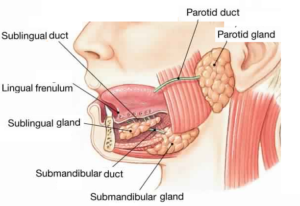Science > Biology > Digestion and absorption in Human > Salivary Glands
There are two sources of digestive enzymes: The glandular cells of the lining of the stomach and intestine, which directly pour their secretion into the lumen of the gut or the alimentary canal. Special glands such as the salivary glands, the liver and the pancreas which pour their secretions into the gut through their ducts. There are three pairs of Salivary glands in our mouth cavity.
Salivary Glands:
Saliva is secreted by salivary glands. Saliva is watery fluid with pH in the range of 6.5 to 7.5. It consists of 98-99% water, 0.2 % salts and remaining digestive enzymes. Salivary glands secrete about 1000 to 1200 ml saliva per day.
- Parotid glands: They are located in front of and below each ear. They produce watery saliva rich in amylase (starch digesting enzyme). The parotid ducts (Stensen’s ducts) open into vestibule opposite the upper second molar teeth.
- Submaxillary glands: They are at the angle of the lower jaw. They produce water and mucus. The submaxillary ducts (Wharton’s ducts) open under the tongue.
- Sublingual glands: They are below the tongue. They produce water and mucus. The sublingual ducts (Duct of Rivinus) open under the tongue.
These glands continuously pour saliva into the mouth cavity. Saliva drains into the mouth through small tubes called ducts. These glands secrete about 1000 to 1200 ml per day.

Functions of Saliva:
- It cleans the mouth cavity and tends to destroy germs with its lysozymes that cause teeth decay. Lysosomes act as antibacterial agents and prevent infection.
- The mucus in saliva moistens and lubricates food which helps in masticating, forming a bolus, and swallowing.
- It acts as a solvent, dissolving some food particles to stimulate taste buds of the tongue.
- Saliva helps in the digestion of food as it contains an enzyme salivary amylase which digests starch converting it into sucrose. That is why starch, when chewed, leaves a sweet taste in the mouth.
- Salivary amylase (ptyalin) hydrolyzes starch and glycogen into maltose, isomaltose, and small dextrins.
- Bicarbonates, phosphates, and mucin neutralize acids in the food and hence act as a buffer.
- Thiocyanate ions act as antimicrobials and prevent infection.
- Enzyme polysaccharidase destroys bacteria.
Problems/diseases Related with Salivary Glands:
- When there is a problem with the salivary glands or ducts, it results in symptoms such as salivary gland swelling, dry mouth (xerostomia), pain fever, foul-tasting into the mouth.
- Salivary stones, or sialoliths: Salivary stones are formed due to the buildup of crystalized buildups. They block the flow of saliva into the mouth. When saliva is not released through the ducts, it backs up into the gland. It causes pain and swelling. To avoid the infection the gland should be cleaned.
- Salivary gland infection or sialadenitis. When the salivary glands get blocked, there is a chance of infection of these glands particularly the parotid gland. The infection creates a painful lump in the gland, and foul-tasting pus drains into the mouth. This infection may cause severe pain, high fevers, and pus in the mouth. It is common in older adults.
- Infections. Viral infections such as mumps and flu can cause swelling of the salivary glands. Swelling happens in parotid glands on both sides of the face. Mumps usually begins approximately 48 hours after the start of other symptoms such as fever and headache.